ÎYÂRHE NAKODA – A wildfire continues to burn out of control near the Îyârhe (Stoney) Nakoda First Nation reserve of Big Horn.
While the fire is about nine kilometres northwest of the community, Alberta Wildfire and local emergency officials say it poses “very limited risk” to it currently.
“The fire is in a very remote area. There’s no road access, but Alberta Wildfire has been using aerial assets to attack the fire,” said Nakoda Emergency Services director Reg Fountain.
“So far, weather conditions have been pushing the fire back into the mountains and away from the Nation.”
The fire was initially assessed on July 23 and has grown to 4,396 hectares. It is burning on the west side of the Bighorn Range, about 20 km west of Nordegg, and is believed to have been caused by lightning.
Two other fires are burning in the area, further west and to the south of the Big Horn reserve. All three fires comprise what is being called the Kiska Complex.
As of Tuesday (Aug. 6), all three fires were a combined 13,864 hectares, with two of three burning out of control and the western-most fire classified as being held.
The latest Rocky Mountain House Forest Area update said there were 39 firefighters, seven helicopters and 38 pieces of heavy equipment assigned to the complex to assist with suppression efforts.
“Cooler temperatures and rain have led to minimal fire behaviour and spread,” states a Monday (Aug. 5) information bulletin
“This precipitation is expected to continue and will likely keep fire behaviour low for the next few days. Crews will take advantage of these conditions to make as much progress possible in suppressing the wildfire and reducing further spread.”
Fountain has been working with Alberta Wildfire to keep Îyârhe Nakoda First Nation appraised of the situation. The Nation is comprised of Bearspaw, Chiniki and Goodstoney first nations, and the Big Horn reserve is home to mainly Goodstoney members.
“We have deployed a liaison team to the Big Horn reserve to assist their band staff should any further actions be required,” he said.
The team consists of two members of the Nakoda Emergency Services fire team, who will be able to work with Alberta Wildfire in its emergency operations centres if needed, including on evacuations.
Currently, no evacuations are necessary, but information will be provided should an alert or order be issued.
Wildfire danger in the Rocky Mountain House Forest Area is rated moderate but a fire ban is in place.
The Calgary Forest Area, which includes the Îyârhe Nakoda First Nation community of Mînî Thnî, as well as Kananaskis and the Bow Valley, is rated extreme.
Alberta Wildfire states that despite recent precipitation, it will take “widespread” rainfall to reduce overall wildfire danger.
“The large fuels in the forest require additional precipitation before their fire danger is significantly reduced. The short-term forecast is calling for a downtrend with increased precipitation and lightning,” states a recent update for the area.
The Local Journalism Initiative is funded by the Government of Canada. The position covers Îyârhe (Stoney) Nakoda First Nation and Kananaskis Country.



